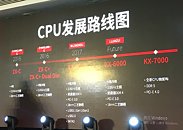- Joined
- Oct 9, 2007
- Messages
- 47,670 (7.43/day)
- Location
- Dublin, Ireland
| System Name | RBMK-1000 |
|---|---|
| Processor | AMD Ryzen 7 5700G |
| Motherboard | Gigabyte B550 AORUS Elite V2 |
| Cooling | DeepCool Gammax L240 V2 |
| Memory | 2x 16GB DDR4-3200 |
| Video Card(s) | Galax RTX 4070 Ti EX |
| Storage | Samsung 990 1TB |
| Display(s) | BenQ 1440p 60 Hz 27-inch |
| Case | Corsair Carbide 100R |
| Audio Device(s) | ASUS SupremeFX S1220A |
| Power Supply | Cooler Master MWE Gold 650W |
| Mouse | ASUS ROG Strix Impact |
| Keyboard | Gamdias Hermes E2 |
| Software | Windows 11 Pro |
The only other active x86 architecture licensee than AMD, VIA Technologies, is planning a comeback to the x86 processor market, bolstered by R&D investment by Shanghai Zhaoxin Semiconductor. VIA and Zhaoxin have been co-developing the ZX family of x86 processors for rollout in 2018, and at least on paper, the chips appear to have the chops to take on Intel's "Gemini Lake" SoCs. The new VIA-Zhaoxin combine CPU family begins with the KX-5000 "Wudaoku" SoCs launched late-2017. These are full-fledged SoCs, which completely integrate the chipset (including the southrbidge).
The KX-5000 chips feature 4 or 8 CPU cores without SMT, 2.00-2.20 GHz nominal CPU clock, 2.40 GHz boost clock, a dual-channel DDR4 IMC, a PCI-Express gen 3.0 root complex, an integrated graphics core, and platform I/O that includes SATA 6 Gbps, and USB 3.1 gen 2. This chip debuted on only one product from a major OEM, the Lenovo M6200 desktop model launched in China. 2018 could see a broader launch of VIA-Zhaoxin chips, with the KX-6000. While the older chips were built on the 28 nm process, the KX-6000 series will be built on the newer 16 nm process, feature 4 or 8 CPU cores clocked at speeds of up to 3.00 GHz, while retaining the feature-set of the KX-5000 series. These chips could realistically be touted as low-cost alternatives to Intel "Gemini Lake" SoCs, although Zhaoxin is making bold claims about its performance nearing that of AMD Ryzen processors.

View at TechPowerUp Main Site
The KX-5000 chips feature 4 or 8 CPU cores without SMT, 2.00-2.20 GHz nominal CPU clock, 2.40 GHz boost clock, a dual-channel DDR4 IMC, a PCI-Express gen 3.0 root complex, an integrated graphics core, and platform I/O that includes SATA 6 Gbps, and USB 3.1 gen 2. This chip debuted on only one product from a major OEM, the Lenovo M6200 desktop model launched in China. 2018 could see a broader launch of VIA-Zhaoxin chips, with the KX-6000. While the older chips were built on the 28 nm process, the KX-6000 series will be built on the newer 16 nm process, feature 4 or 8 CPU cores clocked at speeds of up to 3.00 GHz, while retaining the feature-set of the KX-5000 series. These chips could realistically be touted as low-cost alternatives to Intel "Gemini Lake" SoCs, although Zhaoxin is making bold claims about its performance nearing that of AMD Ryzen processors.

View at TechPowerUp Main Site







